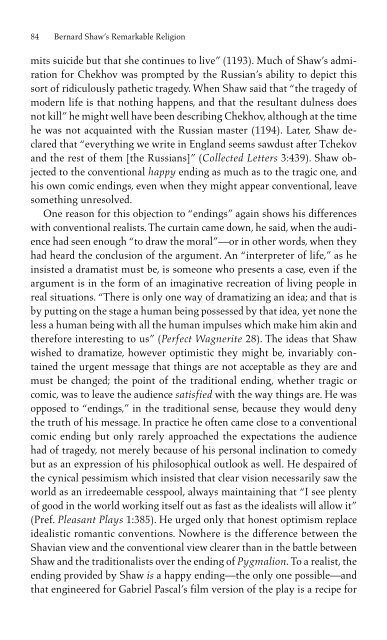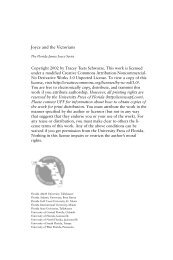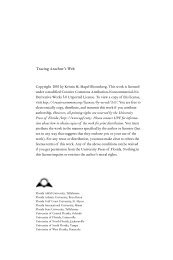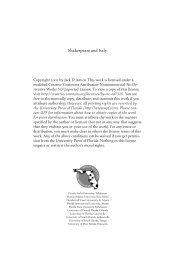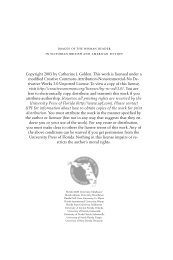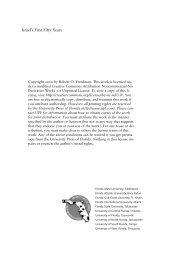Bernard Shaw's Remarkable Religion: A Faith That Fits the Facts
Bernard Shaw's Remarkable Religion: A Faith That Fits the Facts
Bernard Shaw's Remarkable Religion: A Faith That Fits the Facts
Create successful ePaper yourself
Turn your PDF publications into a flip-book with our unique Google optimized e-Paper software.
84 <strong>Bernard</strong> Shaw’s <strong>Remarkable</strong> <strong>Religion</strong><br />
mits suicide but that she continues to live” (1193). Much of Shaw’s admiration<br />
for Chekhov was prompted by <strong>the</strong> Russian’s ability to depict this<br />
sort of ridiculously pa<strong>the</strong>tic tragedy. When Shaw said that “<strong>the</strong> tragedy of<br />
modern life is that nothing happens, and that <strong>the</strong> resultant dulness does<br />
not kill” he might well have been describing Chekhov, although at <strong>the</strong> time<br />
he was not acquainted with <strong>the</strong> Russian master (1194). Later, Shaw declared<br />
that “everything we write in England seems sawdust after Tchekov<br />
and <strong>the</strong> rest of <strong>the</strong>m [<strong>the</strong> Russians]” (Collected Letters 3:439). Shaw objected<br />
to <strong>the</strong> conventional happy ending as much as to <strong>the</strong> tragic one, and<br />
his own comic endings, even when <strong>the</strong>y might appear conventional, leave<br />
something unresolved.<br />
One reason for this objection to “endings” again shows his differences<br />
with conventional realists. The curtain came down, he said, when <strong>the</strong> audience<br />
had seen enough “to draw <strong>the</strong> moral”—or in o<strong>the</strong>r words, when <strong>the</strong>y<br />
had heard <strong>the</strong> conclusion of <strong>the</strong> argument. An “interpreter of life,” as he<br />
insisted a dramatist must be, is someone who presents a case, even if <strong>the</strong><br />
argument is in <strong>the</strong> form of an imaginative recreation of living people in<br />
real situations. “There is only one way of dramatizing an idea; and that is<br />
by putting on <strong>the</strong> stage a human being possessed by that idea, yet none <strong>the</strong><br />
less a human being with all <strong>the</strong> human impulses which make him akin and<br />
<strong>the</strong>refore interesting to us” (Perfect Wagnerite 28). The ideas that Shaw<br />
wished to dramatize, however optimistic <strong>the</strong>y might be, invariably contained<br />
<strong>the</strong> urgent message that things are not acceptable as <strong>the</strong>y are and<br />
must be changed; <strong>the</strong> point of <strong>the</strong> traditional ending, whe<strong>the</strong>r tragic or<br />
comic, was to leave <strong>the</strong> audience satisfied with <strong>the</strong> way things are. He was<br />
opposed to “endings,” in <strong>the</strong> traditional sense, because <strong>the</strong>y would deny<br />
<strong>the</strong> truth of his message. In practice he often came close to a conventional<br />
comic ending but only rarely approached <strong>the</strong> expectations <strong>the</strong> audience<br />
had of tragedy, not merely because of his personal inclination to comedy<br />
but as an expression of his philosophical outlook as well. He despaired of<br />
<strong>the</strong> cynical pessimism which insisted that clear vision necessarily saw <strong>the</strong><br />
world as an irredeemable cesspool, always maintaining that “I see plenty<br />
of good in <strong>the</strong> world working itself out as fast as <strong>the</strong> idealists will allow it”<br />
(Pref. Pleasant Plays 1:385). He urged only that honest optimism replace<br />
idealistic romantic conventions. Nowhere is <strong>the</strong> difference between <strong>the</strong><br />
Shavian view and <strong>the</strong> conventional view clearer than in <strong>the</strong> battle between<br />
Shaw and <strong>the</strong> traditionalists over <strong>the</strong> ending of Pygmalion. To a realist, <strong>the</strong><br />
ending provided by Shaw is a happy ending—<strong>the</strong> only one possible—and<br />
that engineered for Gabriel Pascal’s film version of <strong>the</strong> play is a recipe for


